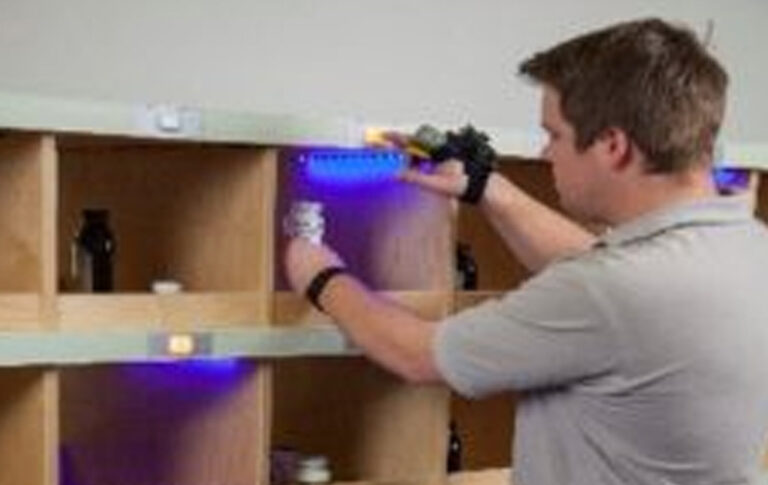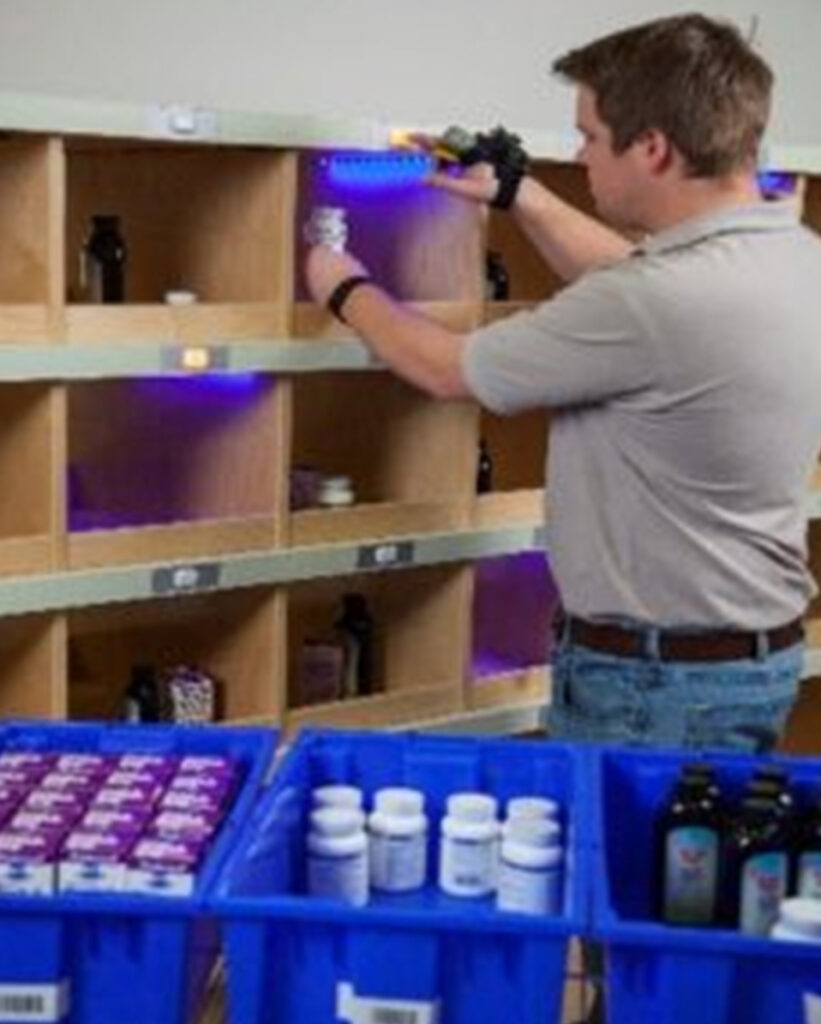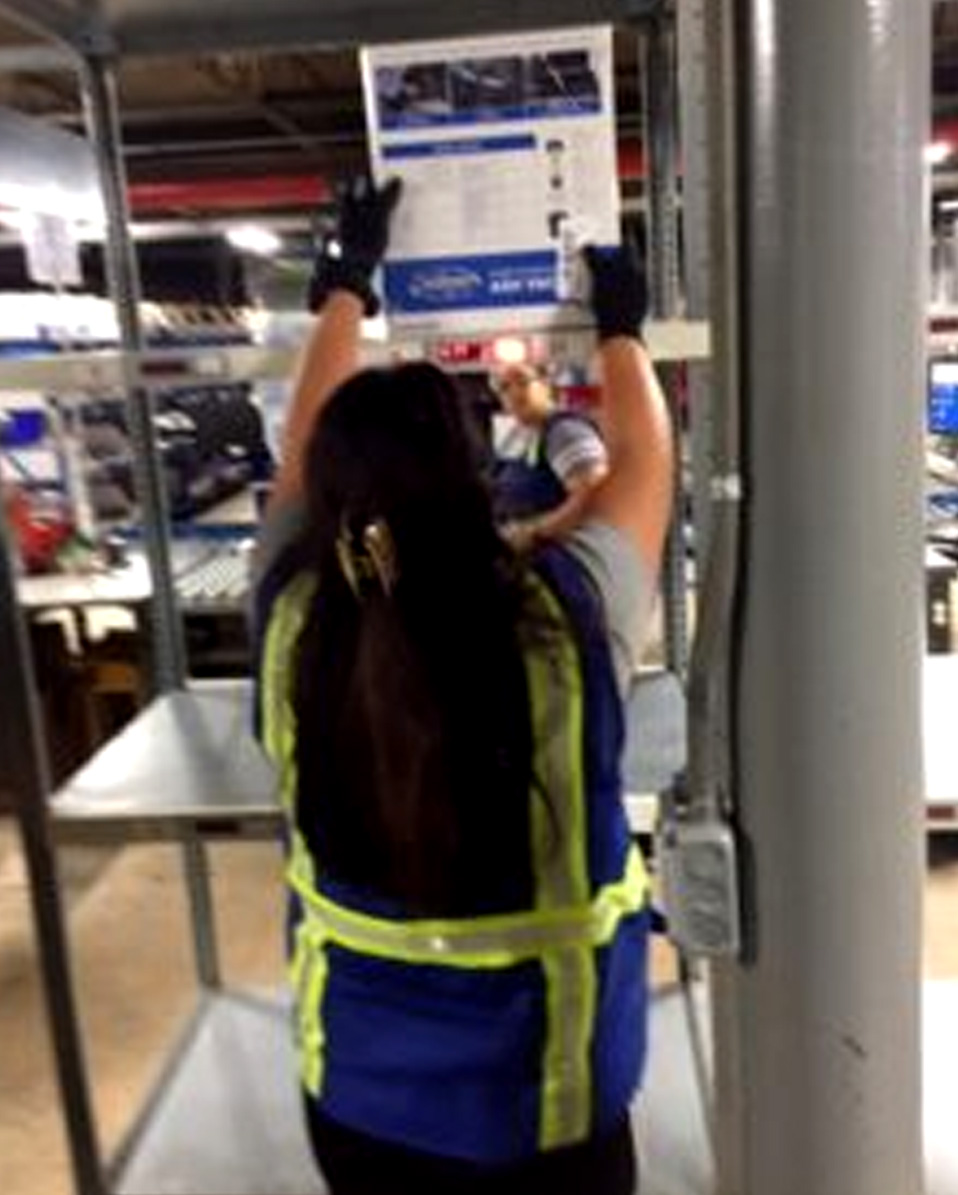
Pick-to-light systems are a fast, simple, and accurate technology solution that increases picking speed and lowers labor costs in case and each order fulfillment operations.
Here’s a brief overview of how a pick-to-light system streamlines labor and increases order throughput.
Pick-to-light (PTL) order picking is essentially a network of displays called pick tags that mount on a rack or shelf channel and use an activity color indicator and alpha-numeric display to direct the operator to pick locations. The pick tag displays the item and quantity required to pick.
Pick-to-light systems are ideal for high-density less-than-case each picking applications and typically uses either a cart or a gravity conveyor to start an order at the initial pick zone. The picking process is a pick-and-pass of the required items across one or several pick zones.
Picking can be performed directly to the shipping carton or to a tote in carton flow racks or shelves with 50 to 100 different products located in a dense slotted pick zone. Several adjacent pick zones can be grouped together to support from 500 to 2,000 or more pick locations.
Pick-to-light systems are significantly faster than paper picking, averaging 300 to 500 lines per man hour depending on item sizes. It is also more accurate than paper picking and wireless terminal-based order picking.
Paper picking is error-prone and requires secondary order checking for item verification at the packing process. This additional step adds duplicate touches and becomes a bottleneck in packing operations, reducing the order fulfillment productivity.
Pick-to-light systems are simple to use and require minimal operator training, so new or temporary workers can be productive in under 30 minutes. This is an important factor for DC managers to consider if they have seasonal peak order volume periods.
Another issue to consider when evaluating the use of pick-to-light systems is the capability of the software managing the order picking operation.
There are several software packages to choose, including a simple configuration and execution application that maps the pick-to-light displays to the warehouse management system, (WMS) database locations.
This type of application, also referred to as pick execution, allows the WMS to control the pick displays at each location. The WMS executes the order picking strategy much like it controls a wireless terminal.
The second option is a complete order fulfillment warehouse automation solution that provides a complete pick, pack, and ship order fulfillment operation for controlling the entire picking process.
This application software can also manage inventory and material handling equipment such as order release, automated conveyors, divert, print-and-apply labeling applications, and order routing and sorting control applications found in a multi-zone, multi-level pick module distribution operations.
In pick modules, the order-picking operation uses an intelligent zone routing conveyor to transport order totes or cartons between each pick zone. Barcode scanners along the conveyor line scan the carton or tote order identification barcode to divert the container to the required pick zone.
Pick-to-light operations in pick modules are best deployed in dense storage pick zones using a combination of pallet flow, carton flow, and walk-back shelving matched to the SKU velocity movement to minimize picking labor and reduce travel/walk time, taking wasted steps out of the order fulfillment operation.

The pick operator or picker at each zone uses a hands-free barcode ring scanner to further gain 5-10% in productivity rates.
The barcode ring scanner lets the operator work hands-free and reduces the time to scan the carton barcode or capture a product lot or serial number during picking.
The barcode scan of the order identifier barcode triggers the pick-to-light displays at each pick location energizing the tag to display the location and quantity for the required order picks.
The operator performs the pick and acknowledges the completion of the item and quantity picked by pushing the color indicator button at each activated location.
The picker walks in pick sequence order pushing the carton or tote along the gravity conveyor to each location. After the last pick in a zone, a zone activity display notifies to the operator that zone picking tasks are complete and the operator pushes the carton on to the powered transport conveyor.
If the order requires additional picks in a downstream zone the tote or carton is diverted to the required pick zone.
When the picking is complete, the order tote or carton is transported to the packing area for completing the packing process; generating the pack sheet, adding void, taper sealing, and performing the shipping manifesting process.
Pick-to-light technology can also be deployed for order packing automation. It is well suited for directing value-add processes at the pack station.
After picking is complete, the order is transported on the conveyor system to the packing area. A pick-to-light shelf adjacent to the pack station can contain 20 or more shelf positions with pre-printed document inserts, special label, promotional items or coupons.
The operator scans the order barcode and the pick-to-light display or a series of the displays at each shelf is illuminated to direct the operator to insert the items required for the order.
The operator then places each product in the carton, and presses an indicator button to confirm the pick and placement into the order carton.
DCs operations where a large percentage of their orders can be picked and completed within the originating pick zone well-suited to order zone picking are.
They are also well-suited to a put wall order consolidation process.
Orders that pick complete in each zone can be a pick-to-carton process directed using RF terminals, pick-to-light or pick-by-voice.
Any order that requires products from multiple zones are picked to a tote and directed to the Put Wall order consolidation area.

Put walls, when incorporated into the right order fulfillment application, can reduce travel times across multiple zones and result in higher order fulfillment productivity and high accuracy due to the secondary scan-and-put validation step.
Put walls essentially work as a sort-by-light operation that directs the operator at the order consolidation area to scan an item’s barcode as it is removed from the tote and put the item on a shelf position based on the pick-to-light display color activity indicator button.
As each item is scanned, the display is energized to direct the placement of the item to a shelf order position. The operator acknowledges the action by pushing the display indicator button.
The operator continues to scan each item, place the items in the totes to each order shelf position and confirms the action using the pick-to-light display button.
On the scan-and-put confirmation of the last order item, the display changes color and a second display on the opposite side of the wall (the pack side) is energized to alert an operator the order is complete and ready for packing.
At the packing station, the operator uses a hands-free wireless scanner and workstation flat display panel to direct the pack and ship operation. Packing can be semi-automatic using a scale, label printer, and pack sheet printer. The workstation display shows the carton size required to pack the order and generate the pack sheet and shipping label.
Options are available to further streamline packing using and automated conveyor pack line with an in-line scan-weigh-dimension system, semi or automatic tapers, and print and apply label application of the shipping label or a combination pack slip/ship label which eliminates 40 seconds of labor in an automated manifesting operation.
RDS™ Pick-to-light or Put-to-Light also works seamlessly with RDS™ Pick-by-Voice for pick-to-conveyor pick modules combined with RDS™ Smart Batch Pick Cart for batch picking 12 to 20 orders at a time outside of the pick module and integrating these orders with the products slotted along the conveyor path.
RDS Pick-to-Light and Pack-to-Light Order Consolidation technologies can work independently or can be used throughout order picking and packing to optimize the entire order fulfillment operation.
Numina Group’s RDS™ Real-time Distribution Warehouse Execution & Control Software, includes a family of pre-developed software application modules that can automate picking for and operation as small as a 30 to 100 product picking or parts kitting operation.
Pick or pack-to-light, managed by RDS™ can be deployed for a small operation or scale to a complete pick, pack, and ship order fulfillment automation system that manages the entire facility including order release, cartonization, pick-by-voice, pick-to-light and put-to-light processes.
RDS™ includes several pre-developed interface modules to connect warehouse pick, pack, and ship automation to existing ERP and WMS systems
RDS™ is a Tier I Warehouse Execution and Control System, (WES-WCS). It includes all the application control modules to manage mid-size to high-volume order fulfillment activities from picking, kitting, packing, order consolidation and shipping operations. RDS is the premier solution proven to lower labor costs and improve profitability throughout the entire distribution operation.
For more information on solutions to improve your distribution center, contact a Numina Group today.